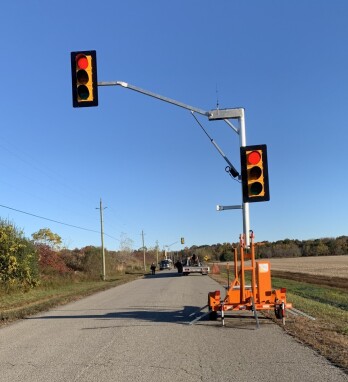The Importance of Innovative Traffic Solutions in Summer Work Zones

As summer construction projects ramp up, ensuring the safety of both workers and motorists is crucial. In 2015, over 96,000 work zone crashes led to 35,000 injuries and more than 700 reported fatalities. Work zones also contribute to congestion, causing nearly one-quarter of all nonrecurring freeway delays. While essential for upgrading city and highway infrastructure, work zone crashes and fatalities have risen in recent years. Effective traffic control is necessary to enhance visibility and guide drivers safely through construction areas. Today’s blog highlights the importance of smart temporary traffic control devices, showing how they can reduce the risk of accidents, minimize confusion and improve overall traffic flow.
Why Work Zone Safety is a Matter for All
Frequent traffic changes, narrowing lanes, nearby traffic control personnel and work vehicles constantly moving in and out make work zones hectic and challenging for passing vehicles. This chaotic environment poses risks not only to motorists but also to highway and road workers. In 2020 alone, 857 people were killed and 44,000 were injured in work zones. Work zone safety is a collective issue that affects everyone, from drivers to passengers to crew members. Having a solid strategy paired with innovative traffic control solutions is crucial. The Federal Highway Administration (FHWA) acknowledges this need and over the years has developed several initiatives to mitigate the safety and mobility impacts of work zones. For example, through its Work Zone Management Program, the FHWA supports transportation practitioners with a comprehensive set of advanced strategies and tools to help plan, design and implement safer, more efficient and less congested work zones. Back in 2015, the FHWA launched the Smarter Work Zones (SWZ) initiative, focusing on two key strategies: project coordination to standardize construction projects and reduce work zone impacts and technology applications to dynamically control traffic in and around work zones. By 2016, nine States had institutionalized project coordination spaces, 18 states had incorporated strategies and software tools into their planning, design, operations and maintenance processes, 11 states had mainstreamed technology tools and strategies and another 28 States had incorporated these applications into their practices. These efforts show the significant impact that coordinated strategies and smart technology can have on traffic safety nearby work zones. By continuing to innovate and adopt best practices, we can create safer environments for both workers and the public, ensuring everyone gets home safely at the end of the day.
Innovative Traffic Control Solutions: Make Roads Safer This Summer!
We can’t expect improvements on our highways and roads without making significant changes. To enhance traffic safety, we need to adopt new strategies and technologies. Here are some smart temporary traffic control devices designed to reduce congestion and accidents while clearly guiding drivers on what actions to take.
Protecting Crew Members with the RCF2.4 and PTL2.4LD
Automated Flaggers enhance safety in work zones by enabling traffic control without placing workers directly in the flow of traffic. The RCF 2.4, Automated Flagger Assistance Device (AFAD), pioneered over 30 years ago, revolutionized temporary traffic control. Operated remotely, one worker can manage two AFADs simultaneously, freeing others for additional tasks and accelerating project completion. Equipped with red and yellow LED lights and a moving gate arm topped with a fluorescent orange flag, AFADs provide a secure solution for short-term work zone traffic control. These portable devices also yield significant cost savings over time, potentially offsetting initial purchase expenses. For sites requiring complete traffic control automation, consider the Portable Traffic Signal Light Duty PTL2.4LD. This compact lane control signal minimizes worker risks and reduces costs associated with work-related incidents. Designed for various short-duration road projects like lane closures, crossroads and intersections, the PTL2.4LD is easy to set up, requiring just one crew member.
How Do Automated Flaggers and Portable Traffic Signals Improve Work Zones?
Automated Flagger Assistance Devices (AFADs) greatly enhance safety in work zones by significantly reducing risks once faced by traffic control persons. Traditionally, flaggers stand close to traffic, putting them at high risk of being struck by vehicles. With the RCF 2.4, flaggers can operate the device remotely, ensuring their safety away from traffic. The PTL2.4LD takes it a step further, allowing you to eliminate the need for a traffic control person entirely. AFADs also advance safety for motorists and other crew members by providing clear, consistent signals, leaving no room for driver confusion. This improves traffic flow and lowers the risk of accidents. Additionally, AFADs increase efficiency, as one traffic control person can manage multiple units, reducing the number of crew members needed to control traffic. This allows you to allocate more resources to the work being done on site, enhancing productivity and shortening project timelines.
Portable Traffic Signals: How the PTL2.4x is Engineered for Work Zone Safety
Portable traffic signals address critical challenges in road construction by minimizing commuter delays, ensuring safety for workers, motorists and pedestrians. The PTL2.4x Portable Traffic Signal is specifically designed for long-term traffic control needs, offering continuous operation. It enhances safety across diverse work zones such as lane closures, crossroads and intersections with robust durability, capable of withstanding temperatures from -40°F to 176°F and winds up to 90 mph. Featuring dual lights for improved visibility in adverse weather conditions, it supports easy setup by a single person, saving time and resources. With multiple operating models tailored for different applications, it provides flexible and effective traffic management solutions.
Improving Work Zones, One Intersection at a Time With NAT
Enhance road safety and streamline traffic flow year-round with North America Traffic. Our advanced Automated Flagger Assistance Devices and Portable Traffic Signals are designed to minimize accidents, clarify traffic situations and improve overall traffic control efficiency, offering dependable solutions for projects of any duration. Connect with us today to explore how our innovative solutions can support your projects. In a dynamic industry, rely on us for stability. Embrace the future of traffic control with our AFADs and portable traffic signals, ensuring uncompromised safety for workers, motorists and pedestrians.
